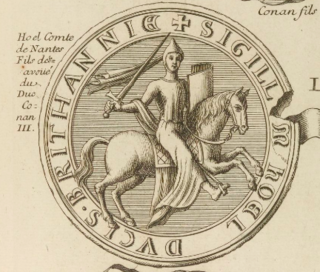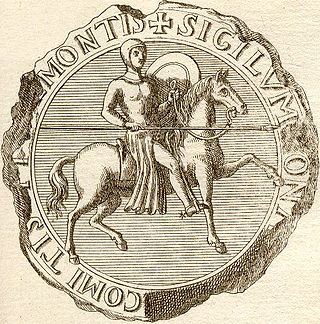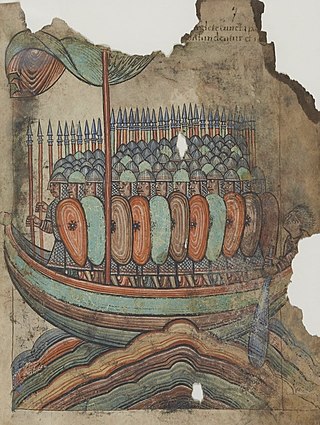Related Research Articles

Geoffrey II was Duke of Brittany and 3rd Earl of Richmond between 1181 and 1186, through his marriage to Constance, Duchess of Brittany. Geoffrey was the fourth of five sons of Henry II of England and Eleanor, Duchess of Aquitaine.

The Duchy of Brittany was a medieval feudal state that existed between approximately 939 and 1547. Its territory covered the northwestern peninsula of Europe, bordered by the Atlantic Ocean to the west, and the English Channel to the north. It was also less definitively bordered by the river Loire to the south, and Normandy, and other French provinces, to the east. The Duchy was established after the expulsion of Viking armies from the region around 939. The Duchy, in the 10th and 11th centuries, was politically unstable, with the dukes holding only limited power outside their own personal lands. The Duchy had mixed relationships with the neighbouring Duchy of Normandy, sometimes allying itself with Normandy, and at other times, such as the Breton-Norman War, entering into open conflict.
Alan I, called the Great, was the Count of Vannes and Duke of Brittany from 876 until his death. He was probably also the only King of Brittany to hold that title by a grant of the Emperor.

Odo of Rennes, Count of Penthièvre, was the youngest of the three sons of Duke Geoffrey I of Brittany and Hawise of Normandy, daughter of Richard I of Normandy. Eudon married Agnes of Cornouaille, the daughter of Alan Canhiart, Count of Cornouaille and sister of Hoel II, Duke of Brittany who was married in 1066 to Eudon's niece Hawise, Duchess of Brittany.
Hoël II was Count of Kernev, from 1058 as Hoël V. On the basis of his marriage to Hawise, Duchess of Brittany, in 1066, he became Duke of Brittany jure uxoris.

Alan IV was Duke of Brittany from 1072 until his abdication in 1112. He was also Count of Nantes and Count of Rennes. His parents were Duchess Hawise and Duke Hoel II. He is also known as Alan Fergant. Through his father, he was of the Breton House of Cornouaille dynasty. He was the last Breton-speaking Duke of Brittany.
Conan III, also known as Conan of Cornouaille and Conan the Fat was duke of Brittany, from 1112 to his death. He was the son of Alan IV, Duke of Brittany and Ermengarde of Anjou.

Hoèl of Cornwall was count of Nantes, from 1148 to his death. He was raised the son of Duke Conan III and Maud FitzRoy, an illegitimate daughter of King Henry I of England. However, he was disinherited by his father when on his death-bed, as Conan III claimed that Hoèl was illegitimate and no son of his. Bertha then became heiress to Duke Conan's lands in Brittany, while Hoèl was allowed to remain Count of Nantes. He was accused by St. Bernard of Clairvaux of having an incestuous affair with his sister Bertha.

Conan IV, called the Young, was the Duke of Brittany from 1156 to 1166. He was the son of Bertha, Duchess of Brittany, and her first husband, Alan, Earl of Richmond. Conan IV was his father's heir as Earl of Richmond and his mother's heir as Duke of Brittany. Conan and his daughter Constance would be the only representatives of the House of Penthièvre to rule Brittany.

Alan, 1st Earl of Richmond, Breton Alan Penteur, also known as "Alan the Black", was a Breton noble who fought for Stephen, King of England. Alan was the third son of Stephen, Count of Tréguier, and Hawise de Guingamp.
Stephen of Penthièvre, Count of Tréguier, 3rd Lord of Richmond was a Breton noble and a younger son of Odo, Count of Penthièvre and Agnes of Cornouaille, sister of Hoël II, Duke of Brittany. In 1093, he succeeded to the title of Count of Tréguier; in 1098, he succeeded his brother Alain as Lord of Richmond in Yorkshire, England.
The noble Breton family line of Porhoët was a French noble family in the middle ages, from around 990 through the 1200's. Notable members included Odo I, Odo II, and Alan I. Alan I would go on to form the Franco-Breton House of Rohan, which survives to the modern day.

Hawise of Rennes was sovereign Duchess of Brittany from 1066 until her death.
Bertha of Cornouaille, also known as Bertha of Brittany, was the Duchess of Brittany between 1148 until her death and Dowager Countess of Richmond. Bertha was the elder daughter of Conan III of Brittany by Maude, the illegitimate daughter of King Henry I of England. She was the last member of the Breton house of Cornouaille to reign over Brittany.
The Count of Rennes was originally the ruler of the Romano-Frankish civitas of Rennes. From the middle of the ninth century these counts were Bretons with close ties to the Duchy of Brittany, which they often vied to rule. From 990 the Counts of Rennes were usually Dukes of Brittany. In 1203 the county was integrated into the ducal demesne. The Count of Rennes was a title held by the House of Rennes.

The Battle of Trans-la-Fôret was fought on 1 August 939 between the occupying Norsemen and the Bretons, led by a joint army of Alan II, Hugh II of Maine, and Judicael Berengar.
Hoël I of Brittany was an illegitimate son of Alan II and Judith. He was Count of Nantes and Duke of Brittany from 960 to 981.
Alain Canhiart was the count of Cornouaille from 1020 to 1058. He was the son of Benoît de Cornouaille and the father of Hoël II, Duke of Brittany. His family name, Canhiart, is understood to be derived from the old Breton Kann Yac'h and was translated into the Latin texts of his era as Bellator fortis.
Guerech of Brittany, was Count of Nantes and Duke of Brittany from 981 to 988.

Vikings were active in Brittany during the Middle Ages, even occupying a portion of it for a time. Throughout the 9th century, the Bretons faced threats from various flanks: they resisted full incorporation into the Frankish Carolingian Empire yet they also had to repel an emerging threat of the new duchy of Normandy on their eastern border by these Scandinavian colonists.
References
- ↑ Judith Everard et Michael Jones, The Charters of Duchess Constance of Brittany and Her Family (1171-1221), p 38